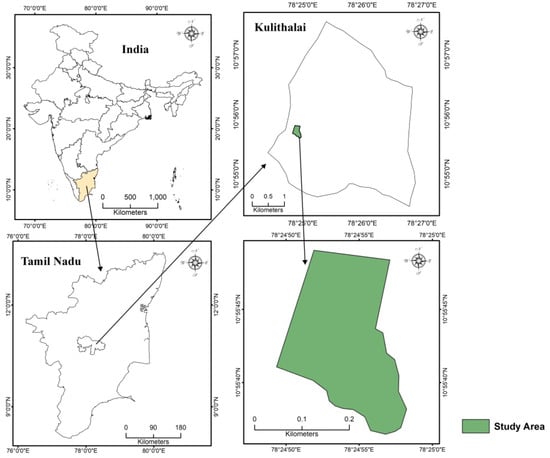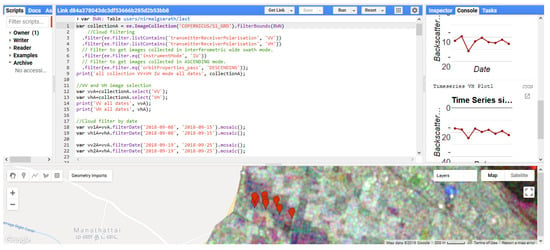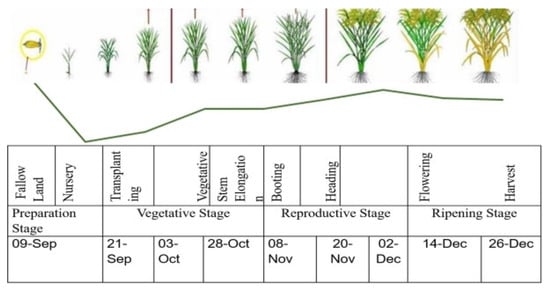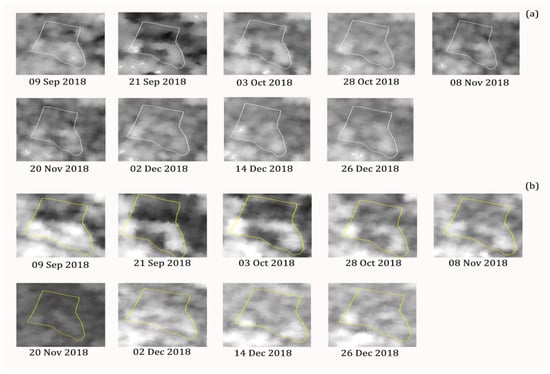Abstract
Rice is the most essential and nutritional staple food crop worldwide. There is a need for accurate and timely rice mapping and monitoring, which is a pre-requisite for crop management and food security. Recent studies have utilized Sentinel-1 data for mapping and monitoring rice-growing areas. The present study was carried out in the Google Earth Engine (GEE), where the Sentinel-1data were used for monitoring the rice-growing area over Kulithalai taluk of Karur district, located along the Cauvery delta region. Normally, the production of rice in the study area starts in the late Samba Season where the long duration variety Cr1009 (130 days) is extensively grown. The results exhibit low backscattering values during the transplanting stage of VV and VH polarization (−15.19 db and −24 db), whereas maximum backscattering is experienced at the peak vegetation stage of VV and VH polarization (−7.42 and −16.9 db) and there is a decrease in the backscattering values after attaining the maturity stage. Amongst VH and VV polarization, VH polarization provides a consistently increasing trend in backscatter coefficients from the panicle initiation phase to the early milking phase, after which the crop attains its maturity phase, whereas in VV polarization, an early peak of backscatter coefficients is seen much earlier during the flowering phase itself. Thus, in this study, VV polarization gives better interpretation than VH polarization in the selected rice crop fields. The obtained results were cross-validated by collecting the ground truth values during the satellite data acquisition time, throughout the crop growing period from the selected rice fields.
1. Introduction
Oryza sativa, the most widely grown rice, is an important stable crop for people worldwide, especially those in Asian countries [1,2]. India, China, Indonesia, Bangladesh and Thailand, tops the production and consumption of rice among the Asian countries [3,4]. In India, the rice is extensively grown in the delta zones of southern and eastern states. The Cauvery delta zone (CDZ) present in the eastern part of Tamil Nadu plays a major role in the production of rice in South India, owing to the presence of fertile alluvial soil and water supply for irrigation from the Cauvery River. As the crop requires more water and is planted during the summer, water from the Cauvery River greatly supports the production of rice in the CDZ. However, in recent years, due to the impact of various anthropogenic activities and climate change, there is a decrease in the availability of sufficient water in the Cauvery River to support the irrigation of crops, especially rice. This eventually decreased the production of rice over the CDZ. Thus, proper mapping and monitoring of rice crops over the whole CDZ can help in taking conservative measures against the decrease in the rice crop production. There are two ways that help in producing maps of rice croplands, which are: (i) manual identification of each rice crop field using a cadastral map, and (ii) heads-up digitization of cropland using high resolution optical and infra-red sensor images. Both of these methods are tedious and time consuming [4]. In this scenario, synthetic aperture radar (SAR)-based crop monitoring techniques have been highly utilised as an alternative because the signals also penetrate the clouds and illuminated situations [5,6]. In recent years, researchers have highly utilised SAR images that have a great advantage in the phenological monitoring of crops [7,8]. High resolution Sentinel-1 SAR images have been recently used in mapping and monitoring the rice fields [9,10]. However, the pre-processing of Sentinel-1 SAR (time series analysis) for monitoring crops can be a time consuming task, where a cloud platform could ease the process. The massive computational power of the Google Earth Engine (GEE) cloud platform can be used for monitoring and mapping of crops over a larger region where a large amount of earth observation (EO) data is available for analysis [11,12,13]. Rice crops were mapped and monitored all over northeast India and Bangladesh using Sentinel-1 SAR images with the help of the GEE platform [14].
In this study, a small rice cropland was selected as a case study in the CDZ, for understanding VV and VH backscatter during different phenological stages of the rice crop. The Google Earth Engine (GEE) cloud platform is used in this study to analyze multiple SAR images, as it reduces the space and time for data acquiring and processing. The backscatter results from this study can be used in classifying the rice croplands in the CDZ using the decision tree technique where thresholds can be set for classifying the rice fields.
2. Study Area
A small rice-growing cropland was selected as the study area, which is situated over the Kulithalai taluk of Karur district, located in the Cauvery delta region. The study area covers a total area of about 0.0631 km2. The region receives high rainfall during the northeast monsoon during the months of October to December. Normally, the production of rice in the study area starts in the late Samba Season where the long duration variety Cr1009 (130 days) is extensively grown. The study area extends from 10°57’30” N latitude to 10°54’31” N latitude and from 78°24’26” E longitude to 78°26’54” E longitude (Figure 1).

Figure 1.
Geographical location of the study area.
3. Dataset
The Sentinel-1A Interferometric Wide (IW) Level 1 GRDH (ground-range detected, high resolution) product was utilised in this study. The 12-day repeat cycle data during the late samba growing season of 2018 from 9 September to 26 December was used in this study, when the rice crop had started growing in the study area. The spatial resolution of the data product is 10 m.
4. Methodology
The whole study was carried out in the GEE cloud platform where the pre-processing steps were carried out in the same way as the Sentinel-1 toolbox. This pre-processing helps in determining the backscatter coefficients in decibels (db) from each pixel. After pre-processing through the GEE platform, the backscatter Sentinel-1 time series SAR images were filtered using the multi-temporal speckle filter in order to remove the noise due to speckle. Smoothing was carried out using a boxcar kernel followed by band stacking, to retrieve the temporal backscatter values of VV and VH polarization over the rice field during the different phenological stages of rice. The ground points have also been corrected in order to verify and validate the calculated backscatter coefficients. Figure 2 represents the workflow carried out in this study.

Figure 2.
Methodology.
The shapefile of the selected rice crop field was ingested in GEE (Figure 3) and a web-based interactive development environment (IDE) code was written using JavaScript (https://code.earthengine.google.com/d84a378043dc3df53666b285d2b53bb8), in order to estimate the backscatter coefficient values in decibels from the rice field. As GEE is a cloud platform, the pre-processing power of the Sentinel-1 SAR images was utilised in this study. The major advantage of GEE is that it can greatly reduce the space and time required for data acquiring and pre-processing. This makes GEE suitable for mapping and monitoring the rice fields throughout the CDZ using the estimated backscatter coefficients from the rice field.

Figure 3.
Deriving backscatter coefficients using Google Earth Engine.
5. Results and Discussion
The sowing of seeds took place on 9 September 2018, while transplantation was carried out on 21 September 2018, followed by reaching the vegetative stage on 3 October 2018 and stem elongation on 28 October 2018. The reproductive stage started with booting on 8 November, followed by the heading stage on 20 November, whereas the ripening stage was witnessed with flowering on 14 December, and the harvest was carried out on 26 December 2018.
Generally, VV backscattering is higher than VH backscattering, and the backscattering coefficients progressively intensify during the crop growing stage and attain a peak between the beginning of the ripening stage and the end of the reproductive stage, after which the backscatter coefficients again start dipping through the mature stage (Figure 4). The VV and VH polarization backscatter images selected over the rice field are shown in Figure 5a,b. The field photographs of the rice field are shown in Figure 6. The results of VV and VH mean backscatter are shown in Figure 7.

Figure 4.
Backscattering trend through different phenological stages of rice.

Figure 5.
(a) VV polarization backscatter images and (b) VH polarization backscatter images.

Figure 6.
Optical rice field photographs.

Figure 7.
VV and VH polarization backscattering coefficients during different phenological stages of rice.
It is evident from the result that a much lower backscattering compared to VV polarization occurs in VH polarization after sowing (on 9 September 2018). This lower backscattering from VH polarization can be due to the presence of bare soil surfaces in the rice field during sowing (Figure 6).
The results from the study show that the backscattering coefficients gradually increase over the phenological development of the rice crop in the field (Figure 7). There is a sudden decrease in the backscattering on 21 September 2018 as there is water over the cropland. Because the crop requires stagnant water in the field during transplantation, this marks a dip in the backscattering of VV and VH polarization. The results exhibit low backscattering values during the transplanting stage of VV and VH polarization (−15.19 db and −24 db), whereas maximum backscattering is experienced at the peak vegetation stage of VV and VH polarization (−7.42 and −16.9 db) and there is a decrease in the backscattering values after attaining the maturity stage. Amongst VH and VV polarization, VH polarization provides a consistently increasing trend in backscatter coefficients from the panicle initiation phase to the early milking phase, after which the crop attains its maturity phase. Whereas in VV polarization, an early peak of backscatter coefficients is seen much earlier during the flowering phase itself. Thus, it is clear that VV polarization backscattering can be used over VH polarization backscattering in order to classify the rice croplands.
6. Conclusions
The present study was carried out in order to calculate the backscattering of VV and VH polarized images during different phenological stages of rice in the study area using the GEE cloud platform. The results clearly show that VV polarization has high backscattering coefficients, and by using these, the length of the growing period and the rice-growing crop fields can be mapped and monitored. It became evident from this study that the usage of the GEE platform helped in quick pre-processing and reduced the space for the data acquisition. Using the parallel power of the GEE platform, the rice cropland present in every delta zone of the whole country can be mapped easily.
Author Contributions
Conceptualization, C.D., J.S.K., S.N.; Methodology, C.D. and S.N.; Software, C.D. and S.N.; Validation, C.D. and S.N. and J.S.K.; Writing-Original Draft Preparation, S.N.; Writing-Review & Editing, S.N. and C.D.; Supervision, J.S.K.
Funding
This research received no external funding.
Conflicts of Interest
The authors declare no conflict of interest.
References
- Muthayya, S.; Sugimoto, J.D.; Montgomery, S.; Maberly, G.F. An overview of global rice production, supply, trade, and consumption. Ann. N. Y. Acad. Sci. 2014, 1324, 7–14. [Google Scholar] [CrossRef] [PubMed]
- Akinbile, C.O.; Abd El-Latif, K.M.; Abdullah, R.; Yusoff, M.S. Rice Production and Water use Efficiency for Self-Sufficiency in Malaysia: A Review. Trends Appl. Sci. Res. 2011, 6, 1127–1140. [Google Scholar] [CrossRef]
- Masutomi, Y.; Takahashi, K.; Harasawa, H.; Matsuoka, Y. Impact Assessment of Climate Change on Rice Production in Asia in Comprehensive Consideration of Process/Parameter Uncertainty in General Circulation Models. Agric. Ecosyst. Environ. 2009, 131, 281–291. [Google Scholar] [CrossRef]
- Nguyen, D.B.; Gruber, A.; Wagner, W. Mapping rice extent and cropping scheme in the Mekong Delta using Sentinel-1A data. Remote Sens. Lett. 2016, 7, 1209–1218. [Google Scholar] [CrossRef]
- Toan, T.L.; Ribbes, F.; Wang, L.F.; Floury, N.; Ding, K.H.; Kong, J.A.; Fujita, M.; Kurosu, T. Rice Crop Mapping and Monitoring Using ERS-1 Data Based on Experiment and Modeling Results. Ieee Trans. Geosci. Remote Sens. 1997, 35, 41–56. [Google Scholar] [CrossRef]
- Onojeghuo, A.O.; Blackburn, G.A.; Wang, Q.; Atkinson, P.M.; Kindred, D.; Miao, Y. Mapping paddy rice fields by applying machine learning algorithms to multi-temporal Sentinel-1A and Landsat data. Int. J. Remote Sens. 2018, 39, 1042–1067. [Google Scholar] [CrossRef]
- Kuenzer, C.; Knauer, K. Remote Sensing of Rice Crop Areas. Int. J. Remote Sens. 2013, 34, 2101–2139. [Google Scholar] [CrossRef]
- Mosleh, M.; Hassan, Q.; Chowdhury, E. Application of Remote Sensors in Mapping Rice Area and Forecasting Its Production: A Review. Sensors 2015, 15, 769–791. [Google Scholar] [CrossRef] [PubMed]
- Bazzi, H.; Baghdadi, N.; Hajj, M.E.; Zribi, M.; Minh, D.H.T.; Ndikumana, E.; Courault, D.; Belhouchette, H. Mapping Paddy Rice Using Sentinel-1 SAR Time Series in Camargue, France. Remote Sens. 2019, 11, 887. [Google Scholar] [CrossRef]
- Ndikumana, E.; Ho Tong Minh, D.; Baghdadi, N.; Courault, D.; Hossard, L. Deep Recurrent Neural Network for Agricultural Classification using multitemporal SAR Sentinel-1 for Camargue, France. Remote Sens. 2018, 10, 1217. [Google Scholar] [CrossRef]
- Gorelick, N.; Hancher, M.; Dixon, M.; Ilyushchenko, S.; Thau, D.; Moore, R. Google Earth Engine: Planetary-scale geospatial analysis for everyone. Remote Sens. Environ. 2017, 202, 18–27. [Google Scholar] [CrossRef]
- Sidhu, N.; Pebesma, E.; Camara, G. Using Google Earth Engine to detect land cover change: Singapore as a use case. Eur. J. Remote Sens. 2018, 51, 486–500. [Google Scholar] [CrossRef]
- Shelestov, A.; Lavreniuk, M.; Kussul, N.; Novikov, A.; Skakun, S. Exploring Google Earth Engine Platform for Big Data Processing: Classification of Multi-Temporal Satellite Imagery for Crop Mapping. Front. Earth Sci. 2017, 5, 17. [Google Scholar] [CrossRef]
- Singha, M.; Dong, J.; Zhang, G.; Xiao, X. High resolution paddy rice maps in cloud-prone Bangladesh and Northeast India using Sentinel-1 data. Sci. Data 2019, 6. [Google Scholar] [CrossRef] [PubMed]
© 2019 by the authors. Licensee MDPI, Basel, Switzerland. This article is an open access article distributed under the terms and conditions of the Creative Commons Attribution (CC BY) license (https://creativecommons.org/licenses/by/4.0/).